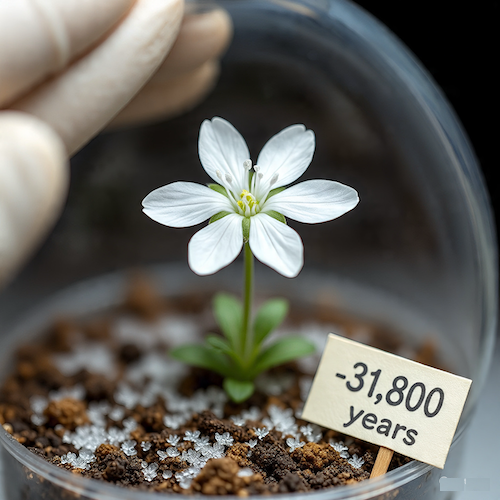The Oldest “Known” Seed Ever Sprouted — a Glimpse of Wonder entry™ —
A tiny seed, no bigger than a grain of rice, slept beneath the frozen banks of a Siberian river. It had been buried there for thousands of years — possibly tens of thousands — tucked into the ancient burrow of a ground squirrel. The squirrel never returned. But the seed endured.
It remained in that frozen chamber, perfectly preserved, longer than any human civilization has lasted. It survived mammoths, ice sheets, and the rise and fall of entire cultures. Then, in 2012, scientists at the Russian Academy of Sciences recovered that very seed from the permafrost and gently coaxed it to life.
What unfurled from that ancient kernel wasn’t a monster from a sci-fi movie. It was a delicate flowering plant — Silene stenophylla (sih-LEE-nee sten-oh-FIL-uh), a small wildflower still found in parts of Siberia today. Incredibly, not only did it grow, but it bloomed and bore viable seeds of its own. A complete life cycle — reignited after being frozen in time for what some estimate could be over 30,000 years.
 Sprouting the oldest known viable seed in the world is a remarkable scientific milestone. But what really stirs wonder is this: the seed wasn’t engineered for survival — it just was. It had no idea it would be buried in sub-zero darkness or that someone would one day dig it up and reawaken it. It simply waited, dormant and ready.
Sprouting the oldest known viable seed in the world is a remarkable scientific milestone. But what really stirs wonder is this: the seed wasn’t engineered for survival — it just was. It had no idea it would be buried in sub-zero darkness or that someone would one day dig it up and reawaken it. It simply waited, dormant and ready.
Even more astonishing? This isn’t the only time it’s happened.
In 2008, a seed found at Masada in Israel — nicknamed “Methuselah” — sprouted after nearly 2,000 years. That one came from a Judean date palm, a plant long thought extinct. And though less dramatic in age, seeds from herbariums and burial sites across the world have surprised scientists with their tenacity. Over and over, life whispers, I’m still here.
Meanwhile, in Yellowstone National Park, USA, entire forests have been found layered one atop another — as many as 27 in a single location. Each tier of petrified trees stands upright, right where they grew, preserved by volcanic activity and mudflows that buried them rapidly. Whether these layers represent 10,000 or 30,000 years, researchers can now trace growth patterns back nearly 40,000 years — but not with absolute certainty. That’s part of the point. When we look at these phenomena, it’s not exact timing that matters — it’s the undeniable continuity of life and growth, even in conditions we don’t yet fully understand.
How could such fragile structures survive for so long? Seeds, stumps, strata — they seem like simple things. But their very simplicity makes them timeless. They were designed that way. And while science keeps trying to push the clock backward, Jehovah, the Creator of time itself, is never racing the clock. He doesn’t need to be.
So what if a seed lies dormant for centuries, or even millennia? Time is no obstacle for the One who designed life to wait — and then begin again.
References
-
Yashina, S. et al. (2012). Regeneration of whole fertile plants from 30,000-y-old fruit tissue buried in Siberian permafrost. Proceedings of the National Academy of Sciences, 109(10), 4008–4013.
-
Sallon, S. et al. (2008). Germination, genetics, and growth of an ancient date seed. Science, 320(5882), 1464.
-
Fritz, W.J. (1980). Reinterpretation of the depositional environment of the fossil forests of Yellowstone National Park. Geology, 8(7), 309–313.
-
Awake!, August 22, 1986, p. 6
-
The Watchtower, April 2017, pp. 6–7 ¶12
-
Taylor, R.E., & Bar-Yosef, O. (2014). Radiocarbon Dating: An Archaeological Perspective. Routledge.



0 Comments
Recommended Comments
There are no comments to display.
Join the conversation with your brothers and sisters!
You are posting as a guest. If you are already a member, sign in now to post with your existing account.
Note: Your post will require moderator approval before it will be visible.